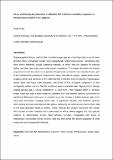Files in this item
Niche partitioning and densities of Albertine Rift endemics and their congeners in Bwindi Impenetrable Forest, Uganda
Item metadata
| dc.contributor.author | Shaw, Philip | |
| dc.date.accessioned | 2015-01-16T16:31:01Z | |
| dc.date.available | 2015-01-16T16:31:01Z | |
| dc.date.issued | 2010-03 | |
| dc.identifier | 161330786 | |
| dc.identifier | 0c9c6ef0-9dff-4d3a-9514-c2ba3448c74a | |
| dc.identifier | 000276576000004 | |
| dc.identifier | 77949611432 | |
| dc.identifier.citation | Shaw , P 2010 , ' Niche partitioning and densities of Albertine Rift endemics and their congeners in Bwindi Impenetrable Forest, Uganda ' , Ostrich , vol. 81 , no. 1 , pp. 7-17 . https://doi.org/10.2989/00306525.2010.455812 | en |
| dc.identifier.issn | 0030-6525 | |
| dc.identifier.other | ORCID: /0000-0002-8183-0289/work/143336068 | |
| dc.identifier.uri | https://hdl.handle.net/10023/6019 | |
| dc.description.abstract | Biogeographical theory predicts that restricted-range species should typically occur at lower densities than ecologically similar, but geographically widespread species. Exceptions may arise where endemics occupy distinctive habitats, in which they are capable of reaching higher densities than their more widespread competitors. This paper describes the habitat requirements and abundance of a sample of insectivores in Bwindi Impenetrable Forest, part of the Albertine Rift mountains Endemic Bird Area. The altitude ranges, habitat preferences, foraging niches and densities of five Albertine Rift endemics from the genera Phylloscopus, Apalis, Batis and Parus were compared with those of their congeners, or with ecologically similar species. The five endemics were associated with ridgetop forest, steeply sloping ground and a sparse understorey or field layer. They foraged within a narrower height range and used a wider range of substrates than their partner species, but showed no significant differences with regard to altitude range, the number of habitat features with which they were associated, foraging niche width or population density. Two endemic apalises were among the most abundant of their genus, achieving densities at least seven times that of the least abundant apalis at Bwindi. These findings are broadly consistent with results from studies of other montane bird communities in Africa, which suggest that bird species endemic to Afromontane forests often achieve densities comparable with those of widespread, ecologically similar species, and may thus avoid the 'double jeopardy' of small range size and low population density. | |
| dc.format.extent | 11 | |
| dc.format.extent | 581535 | |
| dc.language.iso | eng | |
| dc.relation.ispartof | Ostrich | en |
| dc.subject | Conservation status | en |
| dc.subject | Canopy birds | en |
| dc.subject | Abundance | en |
| dc.subject | Tits | en |
| dc.subject | Patterns | en |
| dc.subject | Habitat | en |
| dc.subject | Size | en |
| dc.subject | Area | en |
| dc.subject | Competition | en |
| dc.subject | Breadth | en |
| dc.subject | QH301 Biology | en |
| dc.subject.lcc | QH301 | en |
| dc.title | Niche partitioning and densities of Albertine Rift endemics and their congeners in Bwindi Impenetrable Forest, Uganda | en |
| dc.type | Journal article | en |
| dc.contributor.institution | University of St Andrews. School of Biology | en |
| dc.identifier.doi | 10.2989/00306525.2010.455812 | |
| dc.description.status | Peer reviewed | en |
This item appears in the following Collection(s)
Items in the St Andrews Research Repository are protected by copyright, with all rights reserved, unless otherwise indicated.

